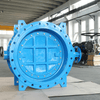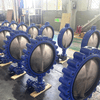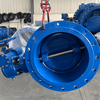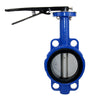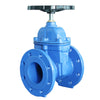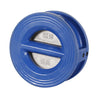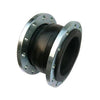Gate and Check Valves: Clear Comparison Guide
Gate valves and check valves are both extensively used and highly common valves in fluid pipeline systems. Today, we’ll explain their differences, applications, and advantages to help you make wiser choices in practical engineering projects.
Core Functions
Gate Valves: Acting like a "switch" in pipelines, their primary role is to completely shut off or open fluid flow. Whether handling water, steam, or oil-based media, gate valves can manually or mechanically control the opening and closing of the flow path. However, they cannot regulate flow rates and are only suitable for fully open or fully closed scenarios.
Check Valves: Functioning as a "one-way door," these automatic valves are designed to prevent media backflow, ensuring unidirectional flow. This characteristic makes them critical "safety guards" at pump and compressor outlets.

Working Principle
Gate Valve:
Operates using external power (manual handwheel rotation or actuator) to vertically raise/lower the gate (wedge or parallel type) via the stem, achieving full flow passage opening/closing.
Check Valve:
Fully automatic operation relying on fluid pressure differential - valve disc opens under forward flow pressure and self-closes against reverse flow.
Structural Features
Gate Valve:
The structure is relatively complex, consisting of a valve body, gate, stem, and handwheel. Its straight-through flow path offers minimal resistance when fully open, making it ideal for high-flow applications. However, prolonged friction between the gate and seat seals can cause wear, requiring periodic replacement of sealing components.
Check Valve:
The design is simpler, with key components including the valve body, disc, and spring (in some types). Common variants include lift-type, swing-type, and butterfly-type check valves. For example:
Swing check valves use a hinged disc that pivots open, suitable for horizontal installation.
Lift check valves rely on vertical disc movement, typically used in vertical pipelines.
Their sealing performance depends heavily on medium pressure, ensuring zero leakage when flow reverses.

Installation Position
The gate valve can be installed in any direction without any restrictions and can be used in both directions. It is commonly used in the following scenarios:
- Pump outlets: For fluid cutoff during maintenance
- Pipeline branches: To isolate different sections
- High-temperature and high-pressure systems: Such as power plant steam pipelines, withstanding pressures over 10MPa
Check valves must be installed according to the medium flow direction (as marked by the arrow on the valve body). Typical applications include:
- Pump and compressor outlets: To prevent equipment damage from backflow during shutdown
- Container discharge ports: To avoid material mixing risks caused by reverse flow
- Fire protection pipelines: To ensure unidirectional water supply and improve system reliability
Advantages and Disadvantages Comparison
Gate valves:
Advantages:
- Extremely low pressure loss when fully open
- Bidirectional sealing with no flow direction restrictions
- Suitable for high-pressure and high-temperature media
Disadvantages:
- Slow opening/closing speed, prone to water hammer
- Sealing surfaces wear easily, resulting in high maintenance costs
- Large dimensions and opening height require more installation space
Check valves:
Advantages:
- Automatic backflow prevention with high safety
- Simple structure and easy maintenance
Disadvantages:
- May cause water hammer impact during reverse flow
- Frequent opening/closing can damage the disc or spring
Classic Combination of Gate Valves and Check Valves
In pump outlet pipelines, a check valve is typically installed first, followed by an isolation valve (gate valve or butterfly valve).
- Maintenance convenience: After closing the isolation valve, the check valve can be removed separately for maintenance without draining the entire pipeline system.
- Water hammer protection: Installing the check valve near the pump outlet allows faster response to pressure fluctuations during pump shutdown, reducing water hammer impact on the pump.
- System reliability: Positioning the isolation valve downstream of the check valve prevents check valve failure caused by accidental closure of the isolation valve.

Flexible Adjustments for Special Scenarios
- While the "check valve first, gate valve second" principle is generally applicable, the following situations require sequence adjustments:
- High-pressure steam pipelines: To protect costly high-pressure gate valves, they may be installed upstream of check valves to bear the initial media impact.
- Parallel pump header systems: Each pump outlet should have a dedicated gate valve to prevent backflow through check valves during maintenance.
- Space-constrained pipelines: Layouts may be adapted to spatial requirements, but must be validated through hydraulic calculations for safety.
Gate valves and check valves serve distinct yet often collaborative functions. Understanding their core differences - while considering operational pressure, media characteristics, and maintenance needs - is essential for building efficient and reliable piping systems.
Thank you for reading. If you're seeking ideal check valves or gate valves, consider Union Valve. As professional valve manufacturers, we offer customizable designs to meet exact specifications. For further inquiries, please contact us.
Related Article:
- Double Flanged vs Lug Type Butterfly Valves: Key Differences
- Characteristics of Resilient Seated Gate Valve and Their Differences from Metal Sealing Gate Valves
- The Difference Between Check Valve And One-Way Valve
- Find Your Match: Butterfly Valve Handle Types Explained

-
Posted in
check valve, Gate valve


